
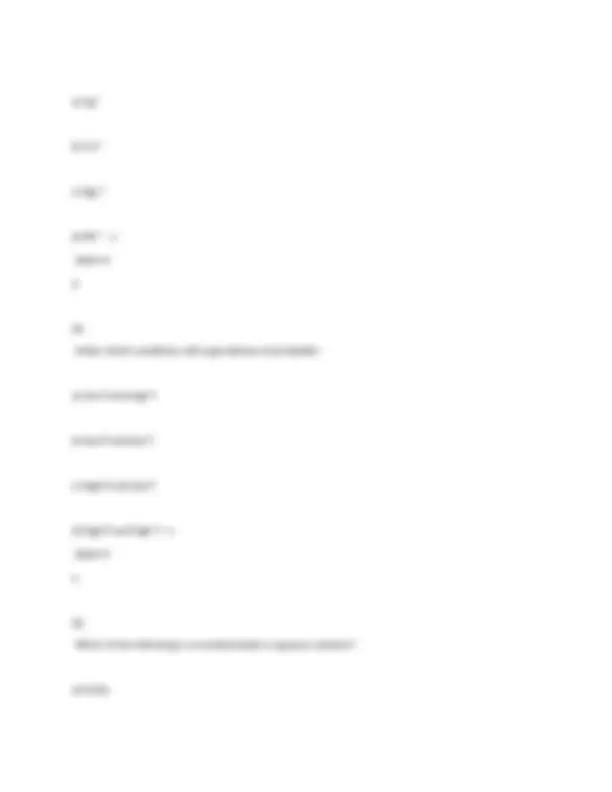
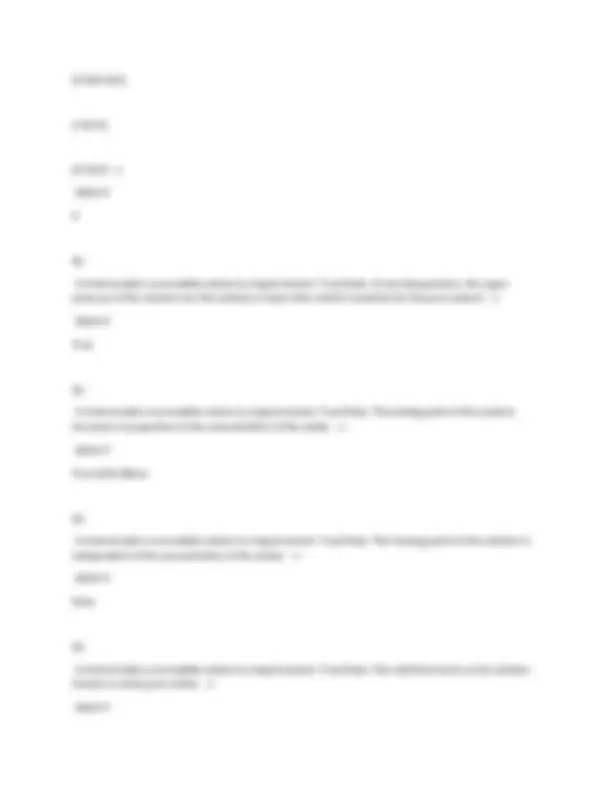
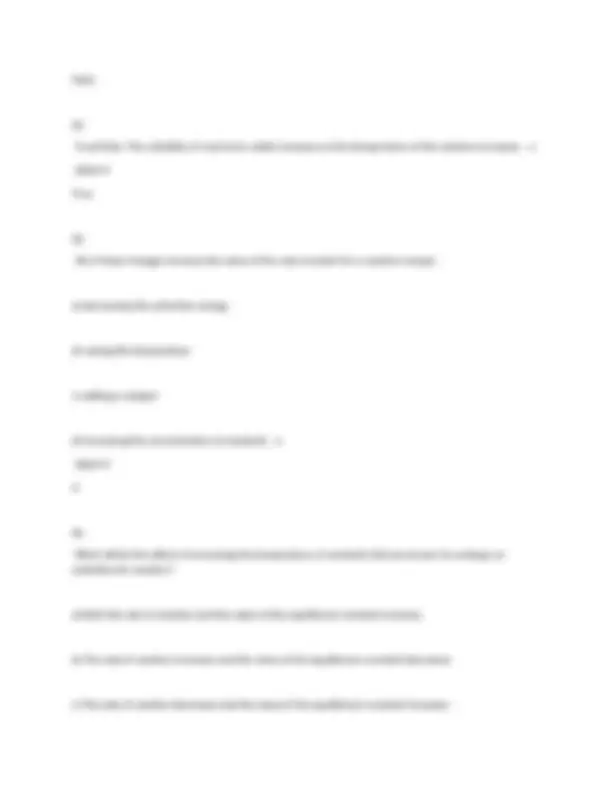
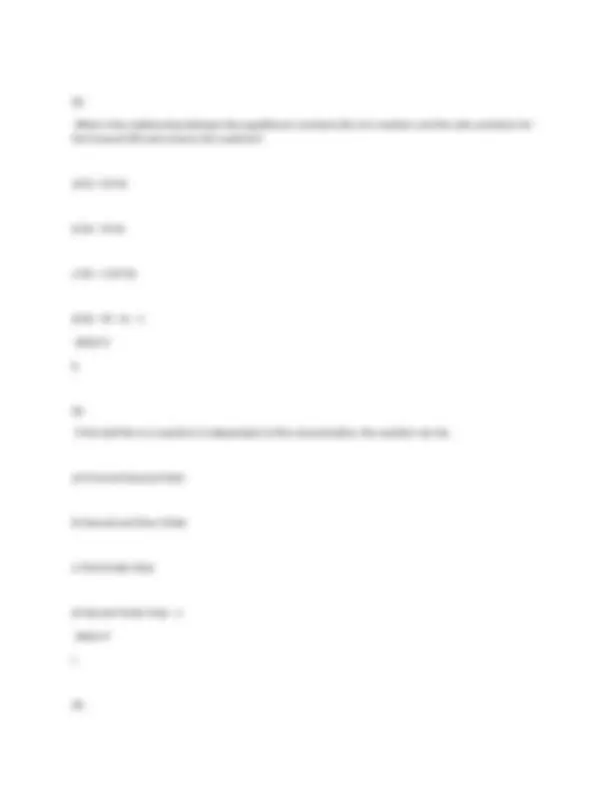
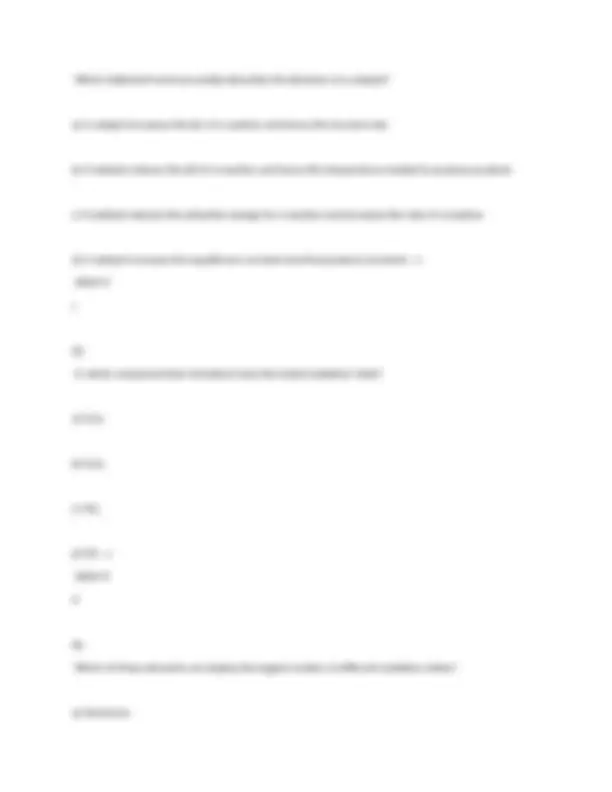
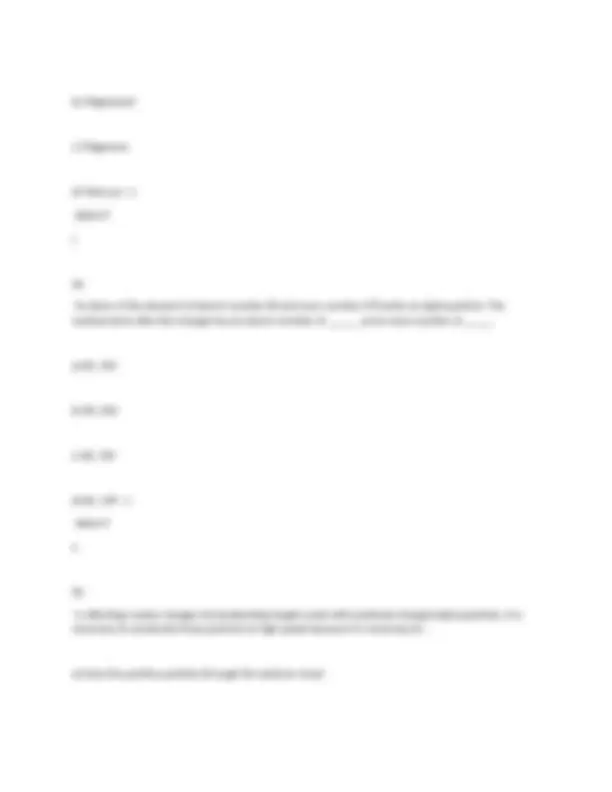
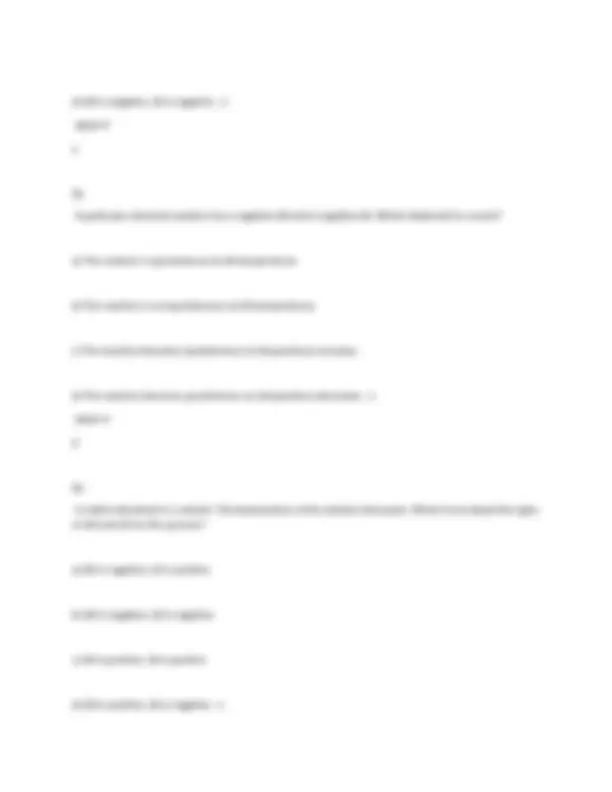
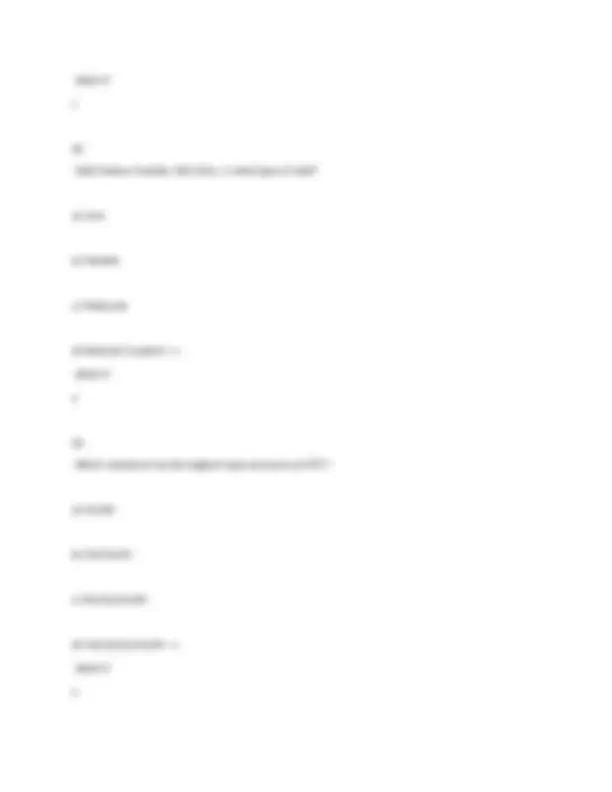
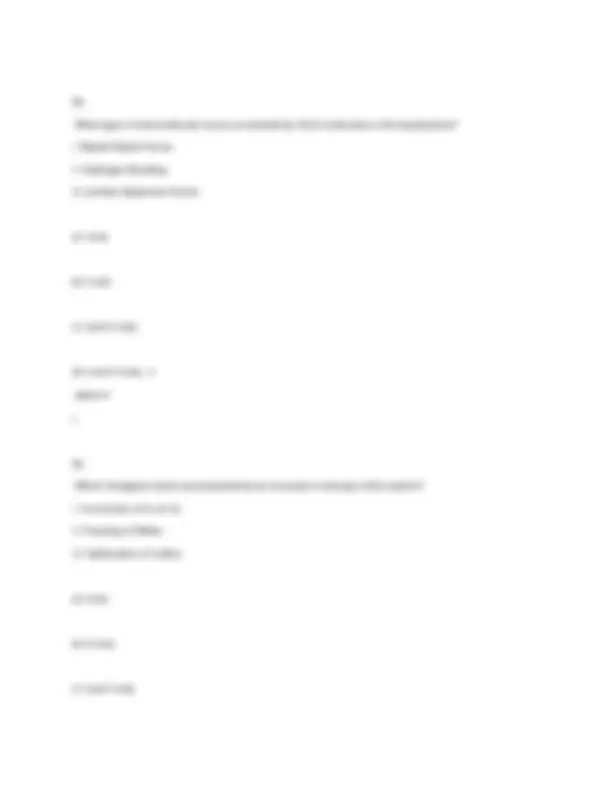
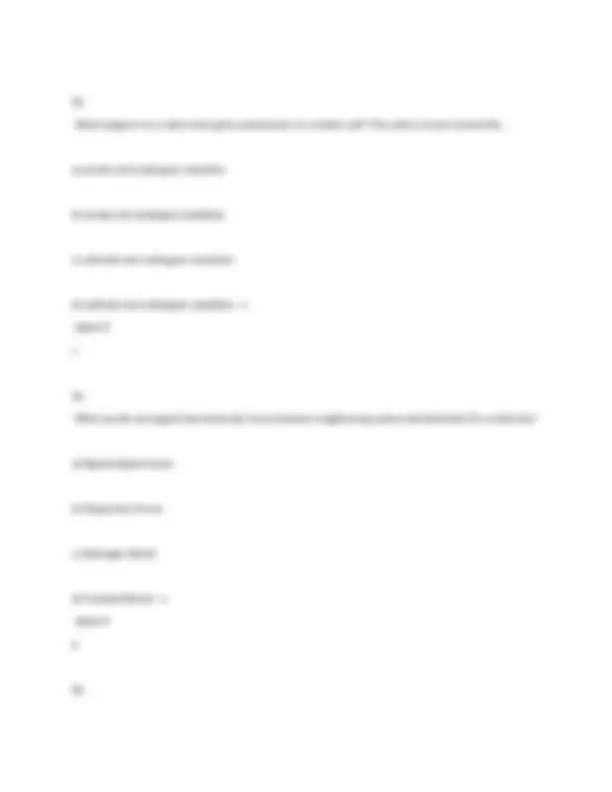
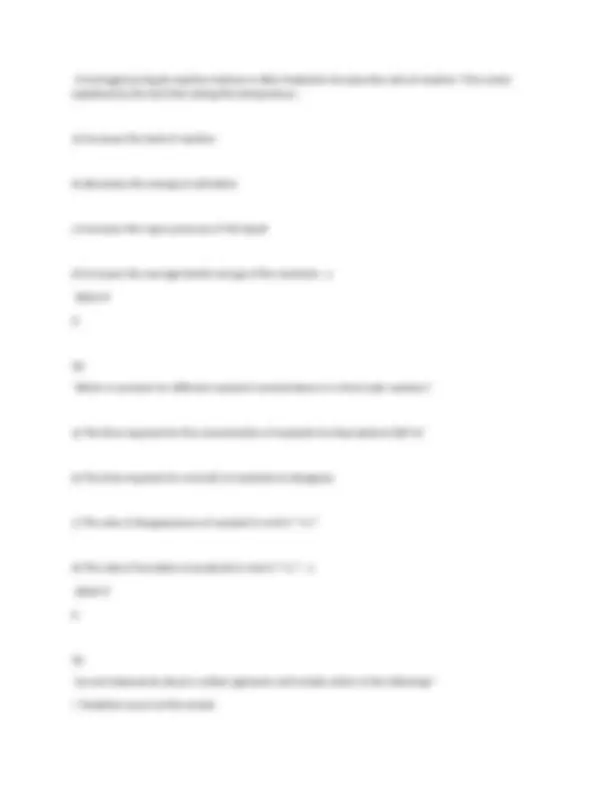
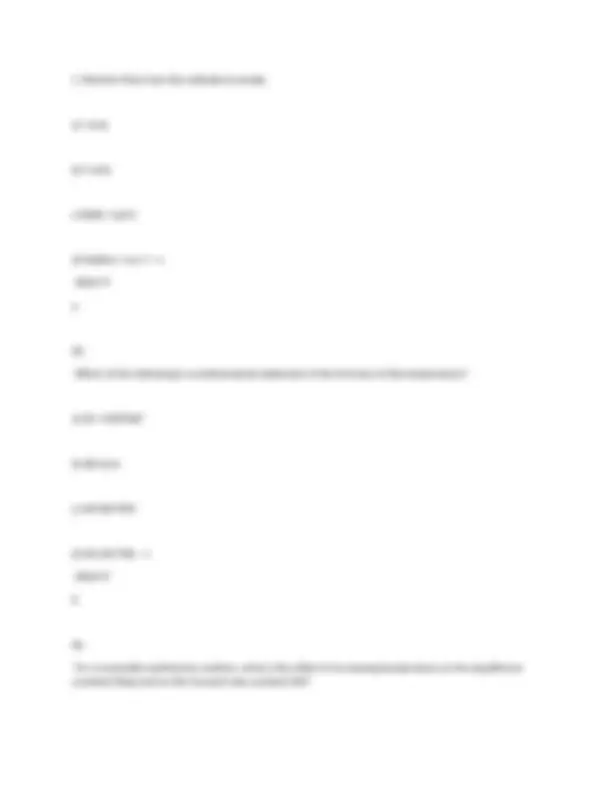
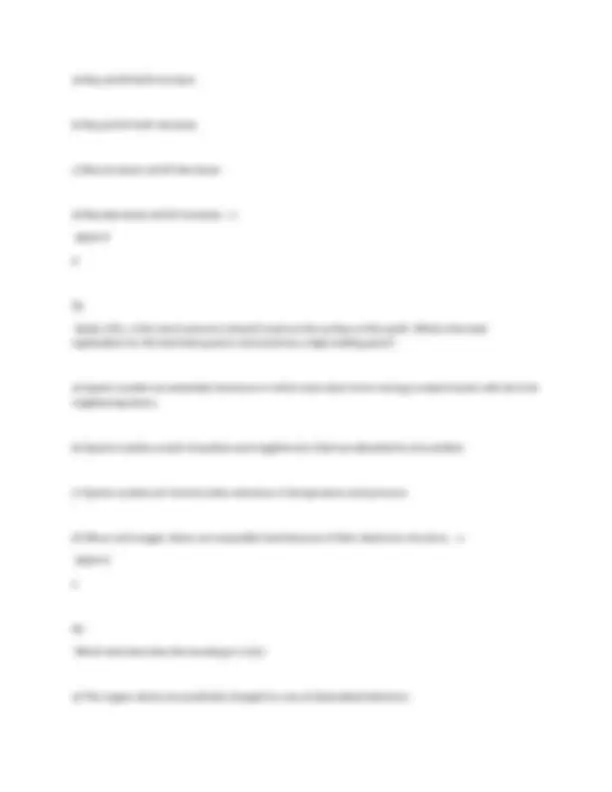
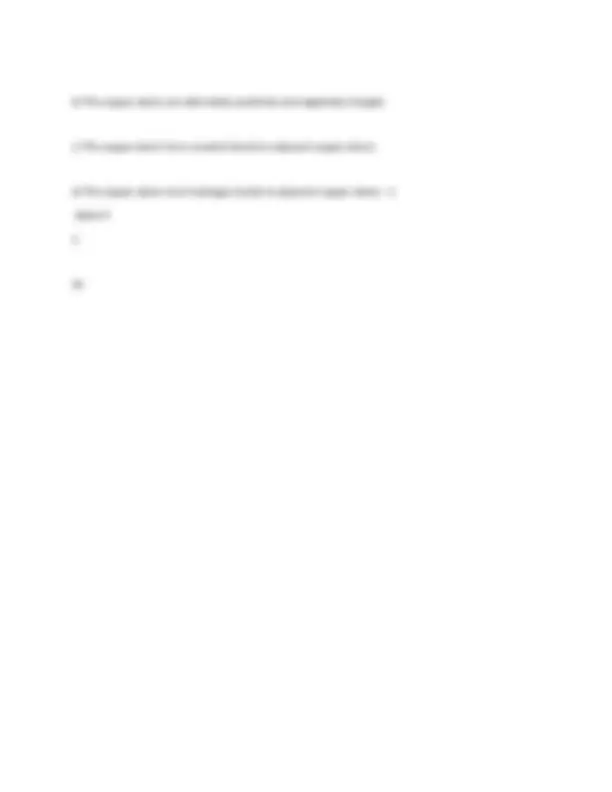


Study with the several resources on Docsity

Earn points by helping other students or get them with a premium plan


Prepare for your exams
Study with the several resources on Docsity

Earn points to download
Earn points by helping other students or get them with a premium plan
Community
Ask the community for help and clear up your study doubts
Discover the best universities in your country according to Docsity users
Free resources
Download our free guides on studying techniques, anxiety management strategies, and thesis advice from Docsity tutors
ACS Study Guide for CHEM 121 and 122 questions with verified solutions Qs Which metal reacts most vigorously with water? a) Ca b) K c) Mg d) Na - n Ans✔ B (K is lower on Column I than Na) Qs Which substance produces an acidic solution when it is bubbled into water? a) CO₂ b) Ar c) NH₃ d) CH₄ - n Ans✔ a
Typology: Exams
1 / 22

This page cannot be seen from the preview
Don't miss anything!















ACS Study Guide for CHEM 121 and 122 Qs Which metal reacts most vigorously with water? a) Ca b) K c) Mg d) Na - n ANS✔✔ B (K is lower on Column I than Na) Qs Which substance produces an acidic solution when it is bubbled into water? a) CO₂ b) Ar c) NH₃ d) CH₄ - n ANS✔✔ a Qs
Which substance is the least soluble in H₂O? a) K₂CO₃ b) KHCO₃ c) Ca(HCO₃)₂ d) CaCO₃ - n ANS✔✔ d Qs Which technique is recommended for determining the odor of an unknown liquid in the laboratory? a) Hold a test tube of the liquid under the nose and inhale the vapor b) Transfer a few drops of the liquid to the desk top and inhale the vapor from there c) use a medicine dropper to collect a small quantity of the vapor and squirt this under the nose while inhaling d) Use a hand to fan some of the vapor from the est tube to the nose and inhale - n ANS✔✔ d Qs A colorless solution is known to contain one of these ions. Which ion is present if adding dilute HCl produces a white precipitate that dissolves when the solution is warmed?
b) NaC₂H₃O₂ c) K₂CO₃ d) CH₂O - n ANS✔✔ d Qs A chemist adds a nonvolatile solute to a liquid solvent. True/False: At any temperature, the vapor pressure of the solvent over the solution is lower than what it would be for the pure solvent. - n ANS✔✔ True Qs A chemist adds a nonvolatile solute to a liquid solvent. True/False: The boiling point of the solution increases in proportion to the concentration of the solute. - n ANS✔✔ True (∆Tb=iKbm) Qs A chemist adds a nonvolatile solute to a liquid solvent. True/False: The freezing point of the solution is independent of the concentration of the solute. - n ANS✔✔ False Qs A chemist adds a nonvolatile solute to a liquid solvent. True/False: The solid that forms as the solution freezes is nearly pure solute. - n ANS✔✔
False Qs True/False: The solubility of most ionic solids increases as the temperature of the solution increases. - n ANS✔✔ True Qs All of these changes increase the value of the rate constant for a reaction except... a) decreasing the activation energy d) raising the temperature c) adding a catalyst d) increasing the concentration of reactants - n ANS✔✔ d Qs What will be the effect of increasing the temperature of reactants that are known to undergo an endothermic reaction? a) Both the rate of reaction and the value of the equilibrium constant increase. b) The rate of reaction increases and the value of the equilibrium constant decreases. c) The rate of reaction decreases and the value of the equilibrium constant increases
b Qs Two reactions with different activation energies have the same rate at room temperature. Which statement correctly describes the rates of these two reactions at the same, higher temperature? a) The reaction with the larger activation energy will be faster b) The reaction with the smaller activation energy will be faster c) The two reactions will continue to occur at the same rates d) A prediction cannot be made without additional information - n ANS✔✔ a Qs A catalyst increases the rate of a reaction by.... a) changing the mechanism of the reaction b) increasing the activation energy of the reaction c) increasing the concentration of one or more of the products d) decreasing the difference in relative energy of the reactants and products - n ANS✔✔ a
Qs What is the relationship between the equilibrium constant (Kc) of a reaction and the rate constants for the forward (kf) and reverse (kr) reactions? a) Kc = kf ∙kr b) Kc = kf/kr c) Kc = 1/kf ∙kr d) Kc = kf - kr - n ANS✔✔ b Qs If the half-life of a reaction is independent of the concentration, the reaction can be... a) First and Second Order b) Second and Zero Order c) First Order Only d) Second Order Only - n ANS✔✔ c Qs
b) Magnesium c) Maganese d) Mercury - n ANS✔✔ c Qs An atom of the element of atomic number 84 and mass number 199 emits an alpha particle. The residual atom after this change has an atomic number of ______ and a mass number of _____. a) 82, 195 b) 84, 203 c) 85, 195 d) 86, 199 - n ANS✔✔ a Qs In effecting nuclear changes by bombarding target nuclei with positively charged alpha particles, it is necessary to accelerate these particles to high speed because it is necessary to... a) drive the positive particles through the electron cloud
b) overcome the force of repulsion of the nucleus c) focus the bombarding particle more accurately d) strip electron from the atom - n ANS✔✔ b Qs From which of these processes is the value of ∆S expected to be negative? I. Sugar is dissolved in water. II. Steam is condensed. III. CaCO₃ is decomposed into CaO and CO₂ a) I only b) I and III only c) II only d) II and III only - n ANS✔✔ c Qs For which process is the entropy change per mole the largest at constant temperature? a) Liquid to Gas
d) ∆H is negative, ∆S is negative - n ANS✔✔ a Qs A particular chemical reaction has a negative ∆H and a negative ∆S. Which statement is correct? a) The reaction is spontaneous at all temperatures b) The reaction is nonspontaneous at all temperatures c) The reaction becomes spontaneous as temperature increases d) The reaction becomes spontaneous as temperature decreases - n ANS✔✔ d Qs A solid is dissolved in a solvent. The temperature of the solution decreases. What is true about the signs of ∆H and ∆S for this process? a) ∆H is negative, ∆S is positive b) ∆H is negative, ∆S is negative c) ∆H is positive, ∆S is positive d) ∆H is positive, ∆S is negative - n
c Qs Solid Sodium Acetate, NaC₂H₃O₂, is what type of solid? a) Ionic b) Metallic c) Molecular d) Network Covalent - n ANS✔✔ a Qs Which substance has the highest vapor pressure at 25°C? a) CH₃OH b) CH₃CH₂OH c) CH₃CH₂CH₂OH d) CH₃CH₂CH₂CH₂OH - n ANS✔✔ a
d) II and III only - n ANS✔✔ b Qs Which units are appropriate for a reaction rate? a) mol ∙L⁻¹ ∙s⁻¹ b) mol ∙L⁻¹ c) mol ∙ ∙L s⁻¹ d) L ∙mol⁻¹ ∙s⁻¹ - n ANS✔✔ a Qs The effect of temperature on the rates of chemical reactions is primarily a result of the... a) size of the colliding molecules b) orientation of the colliding molecules c) enthalpies of the reactants and products d) kinetic energies of the colliding molecules - n ANS✔✔
d Qs The value of the rate constant for a gas phase reaction can be changed by increasing the... a) amount of product b) pressure of the reactant c) temperature of the reaction vessel d) volume of the reaction vessel - n ANS✔✔ c Qs Rate = k[A][B]² How will the rate of this reaction compare if the concentration of A is doubled and the concentration of B is halved? The rate will... a) remain the same b) be double the original rate c) be triple the original rate d) be one-half the original rate - n ANS✔✔ d
A homogenous liquid reaction mixture is often heated to increase the rate of reaction. This is best explained by the fact that raising the temperature... a) increases the heat of reaction b) decreases the energy of activation c) increases the vapor pressure of the liquid d) increases the average kinetic energy of the reactants - n ANS✔✔ d Qs Which is constant for different reactant concentrations in a first-order reaction? a) The time required for the concentration of reactants to drop below 0.001 M b) The time required for one-half of reactants to disappear c) The rate of disappearance of reactant in mol ∙L⁻¹ ∙s⁻¹ d) The rate of formation of products in mol ∙L⁻¹ ∙s⁻¹ - n ANS✔✔ b Qs Correct statements about a voltaic (galvanic) cell include which of the following? I. Oxidation occurs at the anode.
II. Electron flow from the cathode to anode. a) I only b) II only c) Both I and II d) Neither I nor II - n ANS✔✔ a Qs Which of the following is a mathematical statement of the first law of thermodynamics? a) ∆V =(nR/P)∆T b) ∆E=q+w c) ∆H=∆E+P∆V d) ∆G=∆H-T∆S - n ANS✔✔ b Qs For a reversible exothermic reaction, what is the effect of increasing temperature on the equilibrium constant (Keq) and on the forward rate constant (kf)?